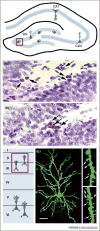Parenting and plasticity
- PMID: 20832872
- PMCID: PMC3076301
- DOI: 10.1016/j.tins.2010.07.003
Parenting and plasticity
Abstract
As any new parent knows, having a baby provides opportunities for enrichment, learning and stress - experiences known to change the adult brain. Yet surprisingly little is known about the effects of maternal experience, and even less about the effects of paternal experience, on neural circuitry not directly involved in parenting. Here we discuss how caregiving and the accompanying experiential and hormonal changes influence the hippocampus and prefrontal cortex, brain regions involved in cognition and mood regulation. A better understanding of how parenting impacts the brain is likely to help in devising strategies for treating parental depression, a condition that can have serious cognitive and mental health consequences for children.
Copyright © 2010. Published by Elsevier Ltd.
Figures


Similar articles
-
Evaluation of parenting interventions for those with additional health and social care needs during pregnancy: THRIVE a multi-arm RCT with embedded economic and process components.Public Health Res (Southampt). 2025 May;13(4):1-138. doi: 10.3310/KYMT5407. Public Health Res (Southampt). 2025. PMID: 40351091 Clinical Trial.
-
Rodent models of social stress and neuronal plasticity: Relevance to depressive-like disorders.Behav Brain Res. 2019 Sep 2;369:111900. doi: 10.1016/j.bbr.2019.111900. Epub 2019 Apr 22. Behav Brain Res. 2019. PMID: 31022420 Review.
-
The neural and hormonal bases of human parental care.Neuropsychologia. 2013 Mar;51(4):731-47. doi: 10.1016/j.neuropsychologia.2012.12.017. Epub 2013 Jan 16. Neuropsychologia. 2013. PMID: 23333868 Review.
-
Short- and long-term alterations of FKBP5-GR and specific microRNAs in the prefrontal cortex and hippocampus of male rats induced by adolescent stress contribute to depression susceptibility.Psychoneuroendocrinology. 2019 Mar;101:204-215. doi: 10.1016/j.psyneuen.2018.11.008. Epub 2018 Nov 11. Psychoneuroendocrinology. 2019. PMID: 30469088
-
Once and Again : History of Rearing Experiences and Psychosocial Parenting Resources at Six Months in Primiparous Mothers.Hum Nat. 2019 Dec;30(4):448-476. doi: 10.1007/s12110-019-09355-3. Hum Nat. 2019. PMID: 31749065
Cited by
-
Parity modifies endocrine hormones in urine and problem-solving strategies of captive owl monkeys (Aotus spp.).Comp Med. 2014 Dec;64(6):486-95. Comp Med. 2014. PMID: 25527030 Free PMC article.
-
Long-term association of pregnancy and maternal brain structure: the Rotterdam Study.Eur J Epidemiol. 2022 Mar;37(3):271-281. doi: 10.1007/s10654-021-00818-5. Epub 2022 Jan 6. Eur J Epidemiol. 2022. PMID: 34989970 Free PMC article.
-
Mating-induced prolactin surge is not required for subsequent neurogenesis in male mice.Front Behav Neurosci. 2023 Jul 6;17:1227726. doi: 10.3389/fnbeh.2023.1227726. eCollection 2023. Front Behav Neurosci. 2023. PMID: 37484521 Free PMC article.
-
Separation increases passive stress-coping behaviors during forced swim and alters hippocampal dendritic morphology in California mice.PLoS One. 2017 Apr 13;12(4):e0175713. doi: 10.1371/journal.pone.0175713. eCollection 2017. PLoS One. 2017. PMID: 28406977 Free PMC article.
-
Differential hypothalamic secretion of neurocrines in male common marmosets: parental experience effects?J Neuroendocrinol. 2012 Mar;24(3):413-21. doi: 10.1111/j.1365-2826.2011.02252.x. J Neuroendocrinol. 2012. PMID: 22070606 Free PMC article.
References
-
- Lonstein JS, De Vries GJ. Sex differences in the parental behavior of rodents. Neurosci Biobehav Rev. 2000;24:669–686. - PubMed
-
- Fernandez-Duque E, et al. The biology of paternal care in human and non-human primates. Annu Rev Anthropol. 2009;38:115–130.
-
- Nadel J, et al. Two-month-old infants of depressed mothers show mild, delayed and persistent change in emotional state after non-contingent interaction. Infant Behav Dev. 2005;28:418–425.
-
- Hay DF, et al. Antepartum and postpartum exposure to maternal depression: different effects on different adolescent outcomes. J Child Psychol Psychiatry. 2008;49:1079–1088. - PubMed
-
- Fihrer I, et al. The impact of postnatal and concurrent maternal depression on child behaviour during the early school years. J Affect Disord. 2009;119:116–123. - PubMed
Publication types
MeSH terms
Substances
Grants and funding
LinkOut - more resources
Full Text Sources
Medical
Research Materials

